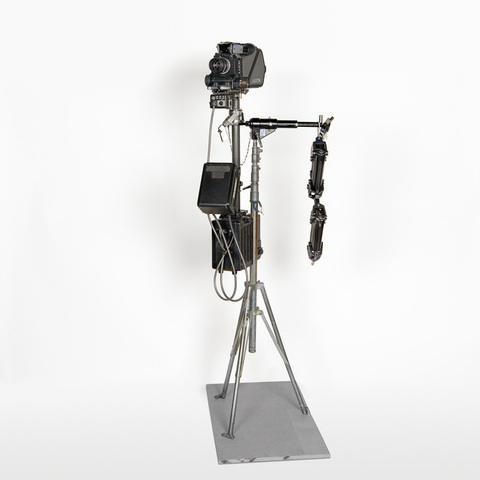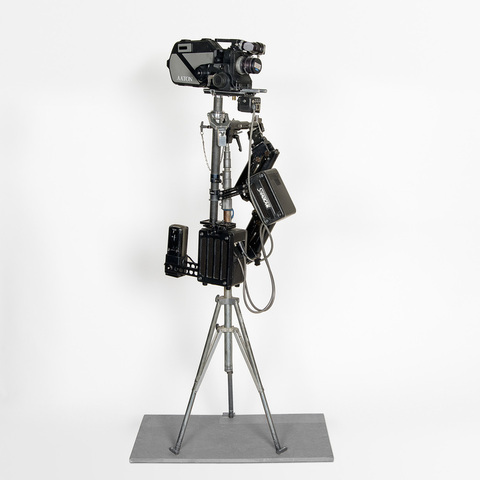Caméra film 35 mm (accessoire de)
Fiche détaillée
Type de l'appareil
pied en métal permettant de poser le Steadicam constitué d'un bras en métal à ressorts, porteur et amortisseur, qui doit s'accrocher sur un harnais et qui porte un ensemble caméra-support (ici, une caméra 35 mm Aaton) ; moniteur écran vert 3 inch ; batterie
Auteurs
Brown Garrett
Philadelphie
Fabricants
Aaton
Grenoble, 2 rue de la Paix
Cinema Products Corporation
Los Angeles, California, 3211 South La Cienega Blvd.
Garrett Brown
Philadelphie
Utilisateurs
Brown Garrett
Philadelphie
Distributeurs
Cinema Products Corporation
Los Angeles, California, 3211 South La Cienega Blvd.
Sujet du modèle
Informations non disponibles
Objectif
Informations non disponibles
Taille de l'objet
Ouvert :
Informations non disponibles
Fermé :
Longueur : 62 cm
Largeur : 50 cm
Hauteur : 181 cm
Diamètre :
Informations non disponibles
Taille de la boîte de transport
Informations non disponibles
Remarques
Marques : "Steadicam 3 A" ; "Cinema Products Corporation Los Angeles CA USA" ; "Steadicam Manufactured by Cinema Products Corp. under lic. from Garrett Brown US Pat. Re. 32 213, 4 156 512, 4 208 028, 4 394 075, and corresponding foreign pat."
Exemplaire provenant de Noël Véry, qui a été l'un des premiers "steadicameur" en France. "Le Steadicam est arrivé en France en 1975. je suis un des deux (avec Yves Nolleau) qui ont commencé à jouer au Steadicam ; au bout de six mois d'autres ont commencé à s'y intéresser (Jacques Monge). Il y a eu une première présentation par la société Bogard au musée Guimet, on a vu arriver cette machine que j'ai trouvée exceptionnelle. Dès le lendemain, je m'entraînai chez François Bogard. Un entraînement sportif fut également nécessaire pour certains tournages (descendre tous les matins les escaliers en marche arrière, se forcer à être ambidextre...)" (Noël Véry, entretien avec Fabienne Costa et Priska Morrissey).
"Il s'agit d'un principe extrêmement simple : l'opérateur transporte lui-même sa caméra, avec l'aide d'un système porteur-amortisseur. Ce système se compose de trois éléments : une veste semi-rigide, qui maintient bien le buste de l'opérateur. - un bras articulé, qui se fixe sur cette veste à la hauteur des abdominaux. Ce bras, muni de puissants ressorts, est à la fois porteur et amortisseur. - un ensemble caméra-support qui se fixe sur ce bras. Ce support fait office de contre-poids à la caméra, qui reste ainsi horizontale par simple gravité : en effet, la liaison entre ce support et le bras amortisseur est assurée par un cardan, type compas de marine, situé très près du centre de gravité de l'ensemble. La caméra devient donc indépendante de l'opérateur ; comme il devient ainsi impossible de viser dans la caméra elle-même, un moniteur vidéo, qui reprend la visée reflexe de la caméra, permet de voir le cadre. L'intérêt d'un tel procédé est de pouvoir effectuer des déplacements de caméra avec la plus grande stabilité, dans des endroits ou cela était impossible jadis, l'opérateur n'ayant qu'à accompagner les acteurs, sans besoin aucun d'aménagement du terrain, il peut ainsi marcher, courrir, franchir des portes, des escaliers, etc. Sur un sol irrégulier, mais sur lequel on peut quand même rouler, il peut aussi utiliser n'importe quel charriot ou véhicule : le bras du Steadicam se charge d'amortir admirablement les chocs, les accoups, ou même les vibrations qui rendraient impossibles des prises de vues traditionnelles. Il est physiquement difficile, et parfois exténuant, de manier ce genre d'appareil car l'ensemble est très lourd, très éprouvant pour le dos, et souvent utilisé dans des conditions assez dures. Cela demande un long apprentissage, puis un entraînement régulier. C'est un procédé délicat à maîtriser : l'opérateur Steadicam dirige lui-même les déplacements de caméra tout en surveillant le cadre sur un minuscule écran TV, qu'il peut d'autant moins regarder que le plan est compliqué, parce qu'il a plein d'autres éléments à contrôler, dont le moindre n'est pas celui de savoir où il met les pieds. Pour moi c'est un procédé fascinant, qui permet de faire des plans extraordinaires et qui m'étonnent toujours" (Noël Véry, Steadicam et Panaglide, les caméras portées-stabilisées, texte sans date conservé dans les archives de la Cinémathèque française).
"The Steadicam has undergone extensive changes, while maintaining the same structural and functional principles. It has been modified, lightened and differentiated to provide a better technical and expressive response to the various requirements which have arisen during its use in may areas : film, television and sports. Garrett Brown, Jerry Holway and others, along with Cinema Products, have carried on a continuing dialogue with Steadicam operators over the years, soliciting comments and listening to a number of suggestions for possible changes born from the operators' personal experiences. Furthermore, in the course of the Steadicam workshops that introduce the Steadicam, teach its use and give an in-depth look at its capabilities and the techniques involved, new ideas arise and are discussed, inspiring changes and new features, accessories and aids such as Antlers, the Bodycam, the Slavecam, etc. The first modifications to the Steadicam arose from the direct experience of Garrett Brown, who experimented with this new tool in the first movies to make use of it : Bound for Glory, Rocky, etc. He immediately felt the need to make the device more versatile and easier to use. Each element was studied and changes were made that always aimed at developing its technical capacity according to the requirements of the shots to be made. At the beginning, the camera was fixed in place, an integral part of the structure ; later the attachment was changed so that the camera could be detached and used alone, making it possible to switch between a 35 or 16 mm camera and a video camera (Universal 1). The viewfinder in Garrett's prototype used a fibre optic bundle from the camera to the eye. Later, a video viewfinder was positioned above the camera. This was lowered to the sled on the Universal model, and finally given an approximately intermediate position on the post between the camera and the battery. During this time, it changed from being a black and white viewfinder to a three-inch green phosphor screen, visible even in sunlight. The arm evolved through five versions with springs and parallelogram links.The versions differed in their weight-bearing capacity, construction materials and in how they were adjusted. Thus it progressed from the early articulated arm, with a natural midpoint where the arm likes to float, to the recent isoelastic arm, characterized by the facts that it neutralizes the weight of the camera in any position in its vertical range, and that its lifting power can be hand-adjusted while holding the rig. It must be emphasized that all elements that make up the rig have evolved including, besides those described above, the various electronic components, the cables, the materials and the accessories" (Serena Ferrara, Steadicam : techniques and aesthetics, Oxford, Focal Press, 2001, p. 44).
"Oscar-winning Steadicam has revolutionized film and video production techniques worldwide. No other single piece of equipment, since the invention of the handheld camera, has ever added so much to the vocabulary of camera movement. [...] Designed to provide total mobility, portability and versatility while recording extremely steady and smooth images, Steadicam permits an infinite variety of both moving and static shots - walking, running, or at standstill. The patented system allows the camera to move with the operator as if it were an extension of their body and part of the human internal servo-system, automatically adjusting and correcting for body motions as the operator guides and controls the camera position with a gentle hand movement. [...] New technology and user input over many years of field experience, have enabled Cinema Products to implement design advances into the new Steadicam Universal Model III A. [...] Steadicam Model IIIA features the new Telescoping / Balance Post, designed to facilitate overall adjustment and enhance maneuverability. The Post may be easily expanded or contracted, allowing the operator to simply adjust camera point-of-view in either high or low modes. The Side-to-Side Camera Balancing Plate provides lateral movement for the Camera Support Platform" (Notice Steadicam Model IIIA, Los Angeles, Cinema Products, s.d.).
Bibliographie
Serena Ferrara, Steadicam : techniques and aesthetics, Oxford, Focal Press, 2001.
Notice Steadicam Model IIIA, Los Angeles, Cinema Products, s.d.
Notice Price List Steadicam Model IIIA, Los Angeles, Cinema Products, 1989.

